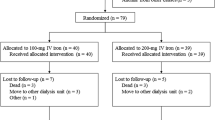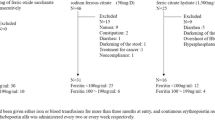Abstract
Iron therapy maintains iron stores and optimizes the response to recombinant human erythropoietin (r-HuEPO) in patients with end-stage renal failure. Information is limited, however, regarding the preferential route of iron administration in pediatric patients receiving hemodialysis. Therefore, we prospectively randomized 35 iron-replete patients (aged >1 to <20 years) to receive up to 16 weeks of maintenance IV (n=17) or daily oral (n=18) iron. Eligible patients had received hemodialysis for >2 months, had a baseline transferrin saturation [TSAT] >20%, and were receiving maintenance r-HuEPO. Treatment arms were evenly distributed with respect to baseline demographic and clinical characteristics, with no statistically significant differences in baseline hemoglobin (Hb), hematocrit (Hct), reticulocyte Hb content (CHr), serum ferritin (SF), TSAT, or r-HuEPO dose. In the 35 patients, IV iron dextran and not oral iron was associated with a significant increase (138.5 to 259.1 ng/ml, P=0.003) in SF. A comparison of the change in SF between the IV iron group and the oral iron group was also significant (P=0.001). Whereas only IV iron was associated with a significant decrease in the dose of r-HuEPO (234.0 to 157.6 U/kg per week, P=0.046) and an increase of the CHr (29.2 to 30.1 pg, P=0.049), these changes were not significantly different from those experienced by patients in the oral iron group. In both groups, the Hct remained stable and in neither group was there a significant change in the TSAT. In summary, although both oral and IV iron maintained patients in an iron-replete state in this short-term study, only IV therapy allowed for a significant improvement in iron stores.
Similar content being viewed by others
References
Eschbach JW, Abdulhadi MH, Browne JK, Delano BG, Downing MR, Egrie JC, Evans RW, Friedman EA, Graber SE, Haley NR, Korbet SM, Krantz SB, Lundin AP, Nissenson AR, Ogden DA, Paganini EP, Rader B, Rutsky EA, Stivelman J, Stone WJ, Teschman P, Van Stone JC, Van Wyck DB, Zuckerman K, Adamson JW (1989) Recombinant human erythropoietin in anemic patients with end-stage renal disease. Results of a phase III multicenter clinical trial. Ann Intern Med 111:992–1000
Eschbach JW, Ergie JC, Downing MR, Browne JK, Adamson JW (1987) Correction of the anemia of end-stage renal disease with recombinant human erythropoietin. Results of a combined phase I and II clinical trial. N Engl J Med 316:73–78
Eschbach JW, Adamson JW (1988) Correction of the anemia of hemodialysis (HD) in patients with recombinant human erythropoietin (rHuEPO): results of a multicenter study. Kidney Int 33:189
Levin NW, Lazarus JM, Nissenson AR (1993) Maximizing patient benefits with epoetin alfa therapy. National cooperative rHu erythropoietin study in patients with chronic renal failure—an interim report. The National Cooperative rHu Erythropoietin Study Group. Am J Kidney Dis 22:3–12
Sobota JT (1989) Recombinant human erythropoietin in patients with anemia due to end-stage renal diasese. Contrib Nephrol 76:166–178
Rigden SP, Montini G, Morris M (1990) Recombinant human erythropoietin therapy in children maintained by haemodialysis. Pediatr Nephrol 4:618–622
Watkins SL, Hickman RO, Avner ED (1990) Dosage and efficacy of erythropoietin in pediatric renal patients. Pediatr Res 27:341A
Eschbach JW, Adamson JW (1989) Guidelines for recombinant human erythropoietin therapy. Am J Kidney Dis 14:2–8
MacDougall IC (1995) Poor response to erythropoietin should be fully investigated and treated. BMJ 310:1424–1425
Sunder-Plassman G, Horl WH (1995) Importance of iron supply for erythropoietin therapy. Nephrol Dial Transplant 10:2070–2076
Van Wyck DB, Stivelman JC, Ruiz J, Kirlin LF, Katz MA, Ogden DA (1989) Iron status in patients receiving erythropoietin for dialysis-associated anemia. Kidney Int 35:712–716
Fishbane S, Maesaka JK (1997) Iron management in end-stage renal disease. Am J Kidney Dis 29:319–333
Besarab A, Frinak S, Yee J (1999) An indistinct balance: the safety and efficacy of parenteral iron therapy. J Am Soc Nephrol 10:2029–2043
Fishbane S (1998) Iron treatment: impact of safety issues. Am J Kidney Dis 32:S152–S156
Tenbrock K, Muller-Berghaus J, Michalk D, Querfeld U (1999) Intravenous iron treatment of renal anemia in children on hemodialysis. Pediatr Nephrol 13:580–582
Allegra V, Mengozzi G, Vasile A (1991) Iron deficiency in maintenance hemodialysis patients: assessment of diagnosis criteria and of three different iron treatments. Nephron 57:175–182
Dunea G, Swagel MA, Bodiwala U, Arruda JAL (1994) Intradialytic oral iron therapy. Int J Artif Organs 17:261–264
Fishbane S, Frei GL, Maesaka J (1995) Reduction in recombinant human erythropoietin doses by the use of chronic intravenous iron supplementation. Am J Kidney Dis 26:41–46
Wingard RL, Parker RA, Ismail N, Hakim RM (1995) Efficacy of oral iron therapy in patients receiving recombinant human erythropoietin. Am J Kidney Dis 25:433–439
(2001) NKF-DOQI Clnical Practice Guidelines for the Treatment of Anemia of Chronic Kidney Disease: Update 2000. Am J Kidney Dis 37:S182–S238
Fishbane S, Lynn RI (1995) The efficacy of iron dextran for the treatment of iron deficiency in hemodialysis patients. Clin Nephrol 44:238–240
Taylor JE, Peat N, Porter C, Morgan AG (1996) Regular low-dose intravenous iron therapy improves response to erythropoietin in haemodialysis patients. Nephrol Dial Transplant 11:1079–1083
MacDougall IC, Tucker B, Thompson J, Tomson CRV, Baker LRI, Rraine AEG (1996) A randomized controlled study of iron supplementation in patients treated with erythropoietin. Kidney Int 50:1694–1699
Yorgin PD, Belson A, Sarwal M, Alexander SR (2000) Sodium ferric gluconate therapy in renal transplant and renal failure patients. Pediatr Nephrol 15:171–175
Greenbaum LA, Pan CG, Caley C, Nelson T, Sheth KJ (2000) Intravenous iron dextran and erythropoietin use in pediatric hemodialysis patients. Pediatr Nephrol 14:908–911
Morgan HE, Gautam M, Geary DF (2001) Maintenance intravenous iron therapy in pediatric hemodialysis patients. Pediatr Nephrol 16:779–783
Fishbane S, Ungureanu VD, Maesaka JK, Kaupke CJ, Lim V, Wish J (1996) The safety of intravenous iron dextran in hemodialysis patients. Am J Kidney Dis 28:529–534
Ruiz-Jaramillo MC, Guizar-Mendoza JM, Gutierrez-Navarro MJ, Dubey-Ortega LA, Amador-Licona N (2004) Intermittent versus maintenance iron therapy in children on hemodialysis: a randomized study. Pediatr Nephrol 19:77–81
Fishbane S, Shapiro W, Dutka P, Valenzuela OF, Faubert J (2001) A randomized trial of iron deficiency testing strategies in hemodialysis patients. Kidney Int 60:2406–2411
Barth R, Aboul-Magd A, Goldwasser P (1995) Response to iron dextran therapy is not precluded by high serum ferritin (Ferr). J Am Soc Nephrol 6:519
Kernilde JJ, Folkert V, Mokrzycki MH (1998) Functional iron deficiency in hemodialysis patients with high ferritin levels. J Am Soc Nephrol 9:253A
Brugnara C, Zurakowski D, DiCanzio J, Boyd T, Platt O (1999) Reticulocyte hemoglobin content to diagnose iron deficiency in children. JAMA 281:2225–2230
Frankenfield DL, Neu AM, Warady BA, Watkins SL, Friedman AL, Fivush BA (2002) Adolescent hemodialysis: results of the 2000 ESRD Clinical Performance Measures Project. Pediatr Nephrol 17:10–15
Hamstra RD, Block MH, Schocket AL (1980) Intravenous iron dextran in clinical medicine. JAMA 243:1726–1731
Bhandari S, Norfolk D, Brownjohn A, Turney J (1997) Evaluation of RBC ferritin and reticulocyte measurements in monitoring response to intravenous iron therapy. Am J Kidney Dis 20:814–821
Brugnara C, Laufer MR, Friedman AJ, Bridges K, Platt O (1994) Reticulocyte hemoglobin content (CHr): early indicator of iron deficiency and response to therapy (letter). Blood 83:3100–3101
Cullen P, Soffker J, Hopfl M, Bremer C, Schlaghecken R, Mehrens T, Assmann G, Schaefer RM (1999) Hypochromic red cells and reticulocyte haemoglobin content as markers of iron-deficient erythropoiesis in patients undergoing chronic haemodialysis. Nephrol Dial Transplant 14:659–665
Fishbane S, Galgano C, Langley RC Jr, Canfield W, Maesaka JK (1997) Reticulocyte hemoglobin content in the evaluation of iron status of hemodialysis patients. Kidney Int 52:217–222
Mittman N, Sreedhara R, Mushnick R, Chattopadhyay J, Zelmanovic D, Vaseghi M, Avram MM (1997) Reticulocyte hemoglobin content predicts functional iron deficiency in hemodialysis patients receiving rHuEPO. Am J Kidney Dis 30:912–922
Tsuchiya K, Okano H, Teramura M, Iwamoto Y, Yamashita N, Suda A, Shimada K, Nihei H, Ando M (2003) Content of reticulocyte hemoglobin is a reliable tool for determining iron deficiency in dialysis in patients. Clin Nephrol 59:115–123
Vaziri ND, Ateshkadi A (1999) Effects of epoetin on vascular biology. Nephrol Dial Transplant 14:46–49
Vaziri ND (2001) Cardiovascular effects of erythropoietin and anemia correction. Curr Opin Nephrol Hypertens 10:633–637
Van Damme-Lombaerts R, Herman J (1999) Erythropoietin treatment in children with renal failure. Pediatr Nephrol 13:148–152
Buckner FS, Eschbach JW, Haley NR, Davidson RC, Adamson JW (1990) Hypertension following erythropoietin therapy in anemic hemodialysis patients. Am J Hypertens 3:947–955
Ifudu O, Friedman EA (1997) Economic implications of inadequate response to erythropoietin in patients with end-stage renal disease. Dial Transplant 26:664–698
Sepandj F, Jindal KK, West M, Hirsch D (1996) Economic appraisal of maintenance parenteral iron administration in treatment of anaemia in chronic haemodialysis patients. Nephrol Dial Transplant 11:319–322
Khan A, Besarab A, Amin NB, Vogel SE, Gupta A, Zazra J, Frinak S, Anandan JV, Zasuwa G (1998) Are there optimal iron parameters for erythropoiesis during maintenance EPO therapy? J Am Soc Nephrol 9:152A
Michael B, Coyne DW, Fishbane S, Folkert V, Lynn R, Nissenson AR, Agarwal R, Eschbach JW, Fadem SZ, Trout JR, Strobos J, Warnock DG (2002) Sodium ferric gluconate complex in hemodialysis patients: adverse reactions compared to placebo and iron dextran. Kidney Int 61:1830–1839
Acknowledgements
This research was supported by a grant from Watson Laboratories.
Author information
Authors and Affiliations
Corresponding author
Rights and permissions
About this article
Cite this article
Warady, B.A., Kausz, A., Lerner, G. et al. Iron therapy in the pediatric hemodialysis population. Pediatr Nephrol 19, 655–661 (2004). https://doi.org/10.1007/s00467-004-1457-5
Received:
Revised:
Accepted:
Published:
Issue Date:
DOI: https://doi.org/10.1007/s00467-004-1457-5




